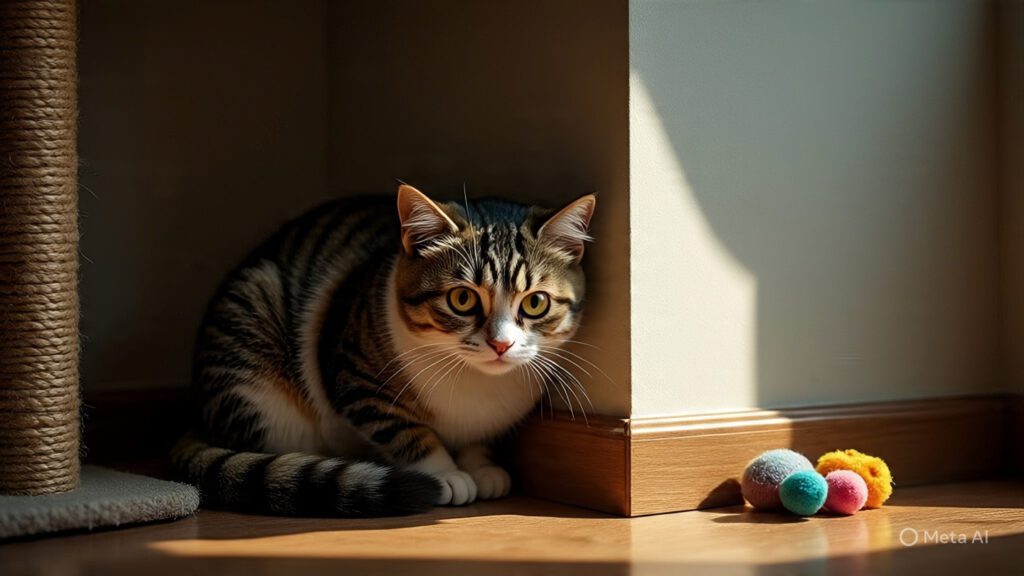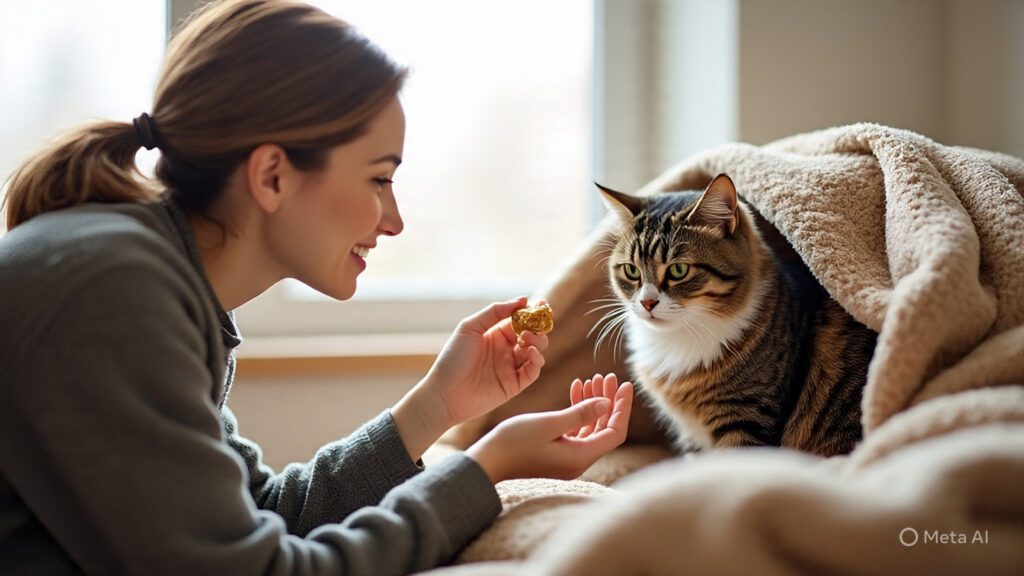Please Note: This post may contain affiliate links. If you click one of them, we may receive a commission at no extra cost to you. As an Amazon Associate, I earn from qualifying purchases.
You know that it's not the same as making friends with a regular dog if you've ever tried to befriend a shy or scared cat.
Dogs are usually all about wagging their tails and giving you slobbery licks. Cats, on the other hand, might behave like they're trying out for a role in a spy movie by sneaking around and hiding when they see a person.
How do we get past that cat fortress and earn their trust? Let's look at some good strategies!
Top Takeaways and Key Concepts
- Observe your cat’s behavior to understand fear or anxiety triggers.
- Create safe, quiet spaces for your cat to relax and hide.
- Use gentle interactions, treats, and positive reinforcement to build trust.
- Introduce new experiences gradually, including people, pets, and play sessions.
- Maintain consistent routines for feeding, play, and quiet time daily.
Article Summary
The article explains how to gain the trust of shy or fearful cats. Key strategies include observing their behavior to understand stress signals and creating safe, quiet spaces where cats feel secure. Gentle, slow interactions paired with treats, positive reinforcement, and gradual exposure to new people or pets help build confidence. Consistent routines for feeding, play, and rest provide predictability, which reduces anxiety. Overall, patience, understanding, and respect for each cat’s personality are essential for forming a strong, lasting bond.
Handy Amazon Shopping Directory for Cat Supplies
Cat Food - Cat Toys - Cat Health - Grooming - Carriers - Cat Beds - Apparel
Furniture - Cat Doors - Collars - Feeding/Watering - Flea/Tick Control - Treats
Video Summary
Jump to Content
Figuring Out How Your Cat Acts

The first step in this complicated dance of gaining trust is to figure out why your cat is shy or scared.
Cats are very sensitive animals, and their instincts warn them to be careful around new people or places.
It's like their way of saying “stay on your toes.” Don't take it personally if your new kitty appears more interested in hiding behind the couch than playing with you.
It's interesting that a lot of things can cause this behavior. Your furry buddy can be nervous because of a past trauma, not being around other cats as a kitten, or just being in a new place.
It's important to know how to tell whether your cat is uncomfortable or anxious so that you can get along with them. If a cat is hiding, flattening its ears, or twitching its tail, it's important to be understanding instead of angry. After all, would you like it if someone came into your personal space when you were feeling weak? The answer is probably no! Cats, like people, have their own limits and likes and dislikes. Respecting these can make a big difference in how they feel.
One important thing to remember is to be patient. It takes time to build trust, just like it takes time to get your friend to try sushi after years of just eating pizza. It takes patient encouragement and the knowledge that change doesn't happen right away. It's vital to give your cat the space they need to get used to new places or experiences without forcing them to interact with you.
Here are some ideas for how to make our shy friends feel safe and comfortable:
1. Safe Spaces: Make sure there are peaceful places in your home where your cat can go when they need to get away from it all. These places could be warm mattresses or places to hide that keep you safe from loud noises or busy activity. Cats typically look for quiet places to rest and recover, so having these safe havens close by will make them feel better.
2. Gentle Interaction: When you want to touch your cat, do so slowly and calmly. Don't make any quick moves that could scare them. Speak softly. Let them come to you when they want to; this gives them power because they are in charge of the interaction.
3. Positive Reinforcement: Give them goodies or praise when they show bravery, as when they explore a new part of the house or let you pet them for a little longer than normal. This helps build trust and makes new encounters more fun.
4. Setting a pattern: Cats do best when they have a pattern. Setting regular hours for eating, playing, and quiet time will help them feel less anxious as they learn what to expect from their surroundings every day.
5. Play that involves other people: Playing with toys like feather wands or laser pointers can help timid cats feel more confident while also giving them mental and physical exercise.
6. Gradual Exposure: If you want your cat to meet new pets or humans, do it slowly. Start with brief encounters that let them take breaks whenever they need to until they get used to being around other people.
7. Calming Aids: If your cat is still anxious during very stressful periods, like moving or greeting new family members, you might want to try pheromone diffusers or sprays made just for cats.
We can assist our shy pets grow into confident creatures that feel safe enough to explore their surroundings without fear holding them back by creating an environment full of kindness and understanding. They will discover that love comes from more than just eating together. It also comes from gaining trust and respect over time, maybe even through some sushi-like adventures along the road!
Making a Safe Place

Now that we know more about our cats, let's talk about making their homes a place where they can feel safe and relax without the loudness and roughness of people, which can be too much for them.
To be fair to them, we're not telling you to turn your living room into a fortress. Instead, we're advising that you should make places for them to snuggle so that they will want to explore, but only if they want to.
First, make sure there are quiet areas and that the blankets are clean and carefully arranged. Every little space is a favorite of cats!
You may even consider about adding more climbing space, like cat trees or climbing shelves, because what cat wouldn't want their own mountain ranges?
Having enough standing room in your cat's space not only gives them room to rest and explore, but it also makes them feel much safer and more secure. Cats are naturally curious, and being able to stretch out, relax, or explore new places can change how they see their territory in a big way. A roomy layout helps individuals feel less trapped and more in charge of their environment, which is important for their health and happiness.
Pheromone diffusers that smell like mother cats are one technique that has worked well for me to make a calming environment. These gadgets function by emitting fake pheromones that act like the calming signals a mother cat sends to her kittens. This can be quite useful for cats who are shy or anxious and may require a little more reassurance as they explore their surroundings. The smell makes the room feel welcoming, which helps reduce stress and anxiety and encourages relaxation.
It's like inviting the coolest person to your house, someone who can calm everyone down right away. Picture yourself arriving into a party where one person is calm. Just being there makes it simpler for everyone else to relax and have fun. These pheromone diffusers also assist make a calm environment where your cats may relax without feeling scared or on edge.
The benefits go beyond just making your cats feel better right away. Using these diffusers frequently can help your cats change their behavior for the better over time. They might get more comfortable over time with going to different parts of the house or spending time with family members, both human and animal. You might see them come out of their favorite hiding places more often or engage with toys instead of just watching from a distance.
Also, using these soothing aids in your daily life will help you and your pets bond more. As they calm down, they will probably want to spend more time with you, whether it's cuddling up next to you on movie evenings or playfully batting at strings during active times together.
In short, making your home a place where your cat may stand up and relax with things like pheromone diffusers not only meets their physical demands but also helps their mental health. You're making their space safer and more welcoming by spending time and money on it. This will make your kittens happier and safer, and they will love exploring while being comfortable at home!
The Art of Patience: Slow Interactions

Once you've made a safe space for your cat, you can start practicing slow interactions. This is like attempting to coax a turtle out of its shell without scaring it.
First, sit next to them but don't look them in the eye because that can be scary. Instead, using your voice and hands softly makes it look like you are employing telepathy.
I think that giving your cat treats is one of the best ways to reward them and make them feel good about being around you. To make this fun experience even better, I propose giving only one candy at a time. Put it behind you in a way that your cat can find it while also connecting your presence with something good, like food. This simple action helps build a relationship built on trust and reward.
As your cat learns that rewards come from you, slowly draw them closer to you. The aim is to get them to come to you on their own, driven by their natural curiosity and hunger. It's interesting how quickly a cat's hunger may make it forget about its first doubts or instincts to be careful. They may be more ready to investigate if they know there is a good treat waiting for them.
Once you've made this connection, keep doing the drill, but not all the time. Start out slowly and keep the amplitude and intensity low during these interactions. Don't make quick movements or flick your fingers, since these could surprise them. Cats are sensitive, and if you overwhelm them right immediately, it can slow down progress instead of speed it up.
Feather wands are a great way to keep your pet busy without overwhelming them. These toys let you play with your cat from a distance and still provide them a fun challenge. The fluttering feathers seem like how prey moves in the natural, which gets their interest without you having to get too close to them. This distance lets them play while still making sure they feel protected and secure.
Chasing after the moving target with feather wands is also a good way to gain exercise because it helps them develop their natural hunting instincts in a fun way. Also, the wand's soft movement makes them want to jump and pounce without feeling scared or overwhelmed by rough play.
In short, giving your cat treats in the right way not only encourages good behavior, but it also builds trust between you and your cat. When you play with feather wands and other gentle toys, you'll make your cat feel safe and comfortable discovering new relationships while having fun with you.
Being Consistent Is Important

You have to be careful when you trust a shy cat, and this is vital since, as the last point, creating these kinds of relationships takes time.
Cats love routines, and if you change anything they are used to, they can go under the couch before you know it.
Make sure they have a plan for how their day will go by setting feeding times and play times.
Fluffy will start to see you as an important part of her routine as she gets used to her new schedule and the many things she does every day. You will go from being a scary giant to a trusted friend—a creature that makes you feel safe instead of scared. This slow change in how you see things is very important for making a solid connection with your cat.
Fluffy may act like she doesn't care sometimes, but deep down, she's looking forward to spending time with you. The time you spend together, whether it's feeding her, playing with her, or just lying on the sofa, will slowly ease any worries she may have had. As she learns to trust you more, you'll be shocked at how rapidly her confidence grows.
It's important to remember that each cat is different and has its own likes and dislikes. Some cats are naturally friendly and warm up to people immediately, while others may take their time getting used to being around people and getting attention. To be a good pet owner, you need to understand these distinctions. This involves being tolerant and flexible in how you deal with them.
For example, one cat could want to be caressed right immediately and seek out attention, while another might need to be coaxed gently before they feel comfortable enough to fully interact with you. Every little step forward should be seen as a big step toward gaining trust.
Also, building this bond means noticing the little things that happen along the road, like Fluffy getting a little closer to you during playtime or finally cuddling up next to you on the couch after weeks of careful watching. You should celebrate these successes since they show that you are making progress on your path together.
In short, accepting the unique traits of each cat makes owning a pet more enjoyable. By meeting their unique needs and characteristics, you are not only improving their lives, but also building a strong relationship that will make both you and your furry friend happy for years to come!
Suggested Resources:
Building Cat Trust: Tips for Owners
https://www.thecatsite.com/threads/building-cat-trust-tips-for-owners.429123/
Understanding Feline Behavior
https://www.felinedomain.com/articles/understanding-feline-behavior/
The Importance Of Safe Spaces For Cats
https://www.cats.org.uk/cat-care/the-importance-of-safe-spaces-for-cats
Frequently Asked Questions
Why are some cats shy or anxious?
Many cats become fearful due to past trauma, lack of early socialization, or entering a new environment. Understanding behavioral signals helps you respond in a patient and supportive way.
What are signs my cat is feeling stressed or uncomfortable?
Common signs include hiding, flat ears, tail twitching, or avoiding eye contact. These indicate your cat needs space and calm surroundings.
How can I create a safe space for my cat?
Provide quiet areas, cozy bedding, high perches, and hiding spots. This helps your cat feel secure while gradually exploring their surroundings.
Do treats help build trust with a shy cat?
Yes, treats can create positive associations and reward brave behavior. Offer small rewards slowly as your cat becomes more comfortable approaching you.
Should I introduce new people or pets quickly?
No, new introductions should be gradual. Short sessions with breaks help reduce fear and allow confidence to grow.
Do routines help anxious cats feel safer?
Yes, predictable routines in feeding, play time, and quiet time reduce anxiety and build trust through consistency.
Can interactive play help shy cats become more confident?
Interactive toys like feather wands encourage safe engagement and exercise. This builds confidence without overwhelming the cat.

Kevin Collier is a dedicated feline enthusiast and expert contributor at CatFAQ.com, where he shares his knowledge on cat health, training, and overall well-being. With years of experience caring for and studying cats, Kevin provides insightful tips and practical advice to help cat owners nurture and understand their pets better. His passion for enhancing the human-animal bond shines through in his articles, making them a valuable resource for anyone looking to improve their cat’s quality of life. Whether it’s training techniques or health care tips, Kevin aims to empower cat owners with the information they need to ensure their furry companions thrive.

